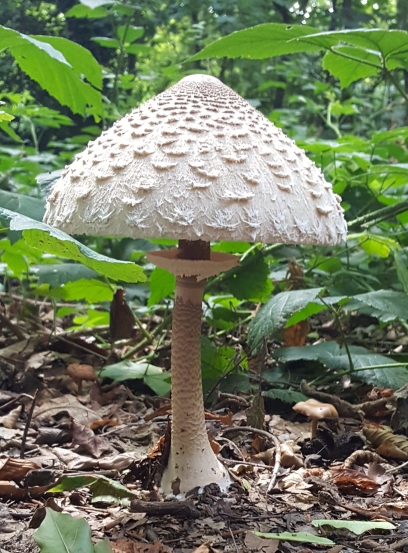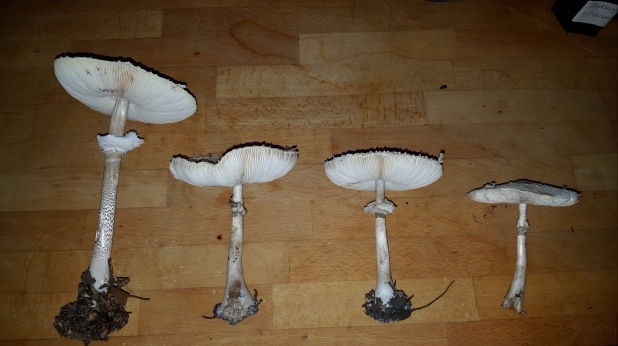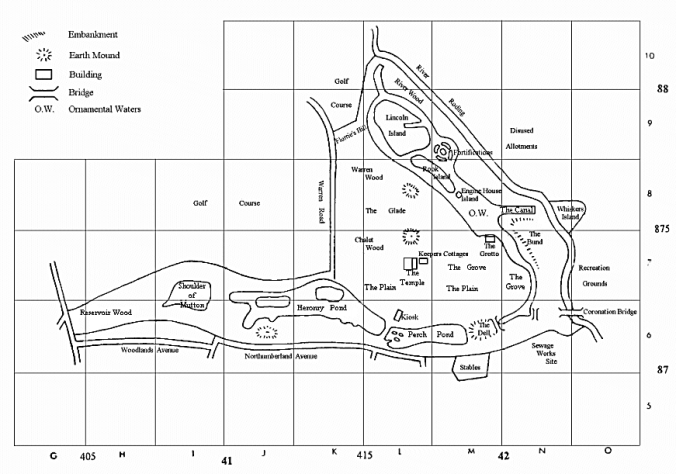I awoke at dawn with a brain full of bees, & so – following a brief session on the mat – decided to head into the woods to see what was what and attempt to calm down the hum inside my mind. I decanted my morning coffee into a plastic bottle, chastising myself for still having not bought a proper thermos flask, and hid my keys under a rock in the back yard. A vague wish to be unencumbered and so more ‘free’ in my surroundings. I hadn’t been out this early before, though I’d been out late; once, for a drunken night-time swim in Shoulder of Mutton pond, and once at full moon with bare feet, in an attempt at the trappings of witchcraft.
Passing St Gabriel’s, I stopped to check on the progress of the mulberry tree in the churchyard, which has recently begun to fruit. Last year I was lucky enough to spot the Leytonstone turaco in this tree – as my girl Louise identified it – an escapee which has been spotted around East London for the past decade.
Today, there was no turaco, and no fruit low down enough for me to pick; though I did find a recently dropped berry on the floor, and found it still sour.
The woods were still, and strange, and full of birdsong. I’m hopeless at bird calls and didn’t manage to identify anything other than the clicking of a coot & the chink of a wren – and the latter only because the book I was currently reading (To the River, by Oliver Laing) had described it as “the sound like a 10p dropped against a bottle”. To the River, I was finding, was a nicely fluid & feminine antidote to the currently hyper-masc world of new nature writing. Following a bad break-up, the author sets out to ‘clear out’ by walking the length of the Ouse, charting as she does the life, death and writing of Virginia Woolf in an aptly meandering fashion. I’d picked it up for obvious reasons; one, Virginia Woolf is my favourite author (I am a woman of few surprises); two, I felt an affinity with the Ouse, which ran through the town where I began; and three, it was (relatedly) the first river of which I’d ever known the name. To me, then, it was The River.
I took my favoured track to the right of Heronry Pond, which heads slightly off the beaten, splitting away from the direct route along the lakeside toward the Temple and threading its way through Aldersbrook Wood before looping back around to the Tea Hut between Heronry and Perch Ponds. I love this time of year in the woods. Yes, the elderflower and the hawthorn blossom and the jack-by-the-hedge (my first and favourite foraging find, for reasons part gastronomical part sentimental) have all gone over, but the banks of the ponds are full of brazen yellow ragwort, and tall, nodding rosebay willow-herb. I love rosebay willow-herb – a plant so good they named it after four other plants! – despite its madly invasive nature. It’s a treat on the Flats in June and July, clustered pink spires against the yellow of the gorse.
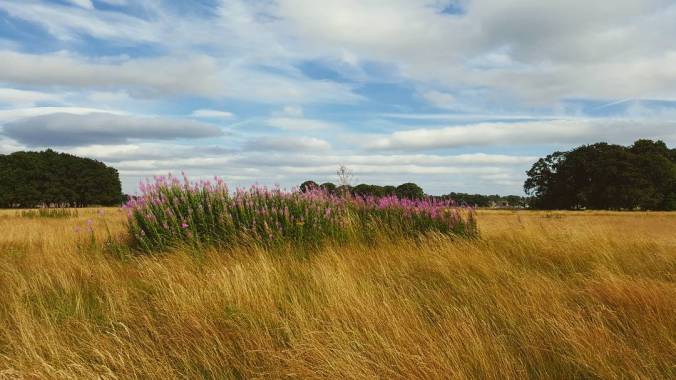
Rosebay willow-herb on Wanstead Flats
I picked my way along the path, glad I opted for trainers instead of sandals at the last minute, enjoying the cool of the morning before the day started to heat up again. It had been a long and balmy heatwave for the past few weeks, and the faces of tube commuters in the evenings were beginning to look distinctly broiled. I’d caught the sun a little on my arms, I noticed; not the burnished gold that one might hope for, but the more pink and british look of mottled ham. ‘Dragonfly Corner’ was quiet, but later in the day the air here would be full of electric blue flashes. In the grassland just north of Northumberland Avenue (northnorthumberland) I met a black cat that I wasn’t initially sure was a cat (fox? muntjac? devil?) who eyed me haughtily, rightly suspicious of any human intruding on its patch at this time of the morning.
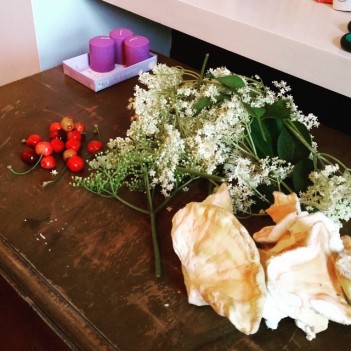
Chicken of the woods from the same tree in 2015 (but a month earlier! WHAT DOES IT MEAN)
A little before the path doubled back around Heronry Pond, I set off through the undergrowth to check on ‘Chicken-of-the-Woods Log’. Last year was a poor year for it, and I was worried it might never grow back; today, I was glad to find two large frilly growths clinging parasitically to the dead tree. Apparently you should never eat chicken-of-the-woods growing on conifer, eucalyptus or cedar trees, as this will make the fungus toxic; here, it was on a fallen oak so perfectly palatable. Chicken-of-the-woods is one of only three mushrooms I can positively identify, and one of only two I’d be comfortable to actually bring home and work with. Always found on dead or dying wood, it’s easily recognisable by its huge overlapping yellow/salmon plates, and makes a fine chicken substitute (hence the name). Texturally, it’s quite similar to reconstituted chicken or quorn chicken, though drier – when cooking it, it’s best to add it to recipes with lots of liquid, like risottos or soups, as otherwise it can end up quite dehydrated and ‘woody’. The taste is similar to chicken, but with a lemony taste and a slight earthy bitterness. It can be frozen, pickled or dried – but I’ve never had much luck with drying, ending up with a box of mouldy mushrooms. I broke off only a little today, to keep fresh in the fridge for a stir-fry on Wednesday.
I cast a wider loop than usual and opted to walk on past Perch Pond before aiming back towards home. The park entrance gate on Wanstead Park Avenue was covered in screaming posters; three advising residents that there was new housing development planned in Aldersbrook Reservation Area and that this was A Very Bad Thing, and two warning that Heronry Pond has been confirmed to be full of blue green algae. Blue green algae is toxic to dogs, and common in hot weather (of which there has been far too much for my liking). I could see it from where I stood, a deep turquoise sheen across the surface of the water. The stinking, stagnant water of Heronry Pond is a perfect breeding ground for it; the ponds in Wanstead Park are man-made, and were constructed in the 1730s, back when the park was the grounds of the home of the Earl of Tylney (on which more here). Though fed by a dam from Perch Pond, to the north, the pond has apparently had issues with water retention since the early 1900s. This year, it had been completely dry throughout most of April and May, allowing me to walk across the lake-bed and visit Heronry Island, home to a vixen with a scraggy tail and her two rambunctious cubs which I’d watched chase each other in the twilight.
No herons on Perch Pond today, disappointingly. I set a course toward home, pausing near The Temple to gather some yarrow. I’m still not sure what to do with yarrow; to me, it tastes a little like oregano, but not pleasant enough to use as a herb. Some people use it to create a tincture which is used as a wound healer; my foraging has not quite progressed into the medicinal arena yet, which I still retain a hefty degree of scepticism about. I’m interested, historically, in how plants were used as folk medicine; less interested in trying it myself, and quite happy personally to stick with the (much beleaguered, woefully underfunded, desperately important) NHS.
It’s on my way home that I realised I’d been composing narrative in my head for the past half an hour or so, in a daze of words and sentence fragments that mirrored and matched my ambulations. I was reminded, once more, of a passage from To the River, where Laing herself quotes both Virginia Woolf and Kenneth Graham (a spot of matryoshka doll citation, there…)
I was getting anyway into one of those trances that come from walking far, when the feet and the blood seem to collide and harmonise. Funnily enough, Kenneth Grahame and Virginia Woolf both wrote in praise of these uncanny states, which they thought closely allied to the inspiration writing requires. ‘Nature’s particular gift to the walker,’ Grahame explained in a late essay, ‘through the semi-mechanical act of walking – a gift no other form of exercise seems to transmit in the same degree – is to set the mind jogging, to make it garrulous, exalted, a little mad maybe – certainly creative and supra-sensitive, until at last it really seems to be outside of you and as it were talking to you, while you are talking back to it.’ As for Woolf, she wrote dreamily of chattering her books on the crest of the Downs, the words pouring from her as she strode, half-delirious, in the noonday sun. She compared it to swimming or ‘flying through the air; the current of sensations & ideas; & the slow, but fresh change of down, of road, of colour: all this is churned up into a fine thin sheet of perfect calm happiness. Its true I often painted the brightest pictures on this sheet: & often talked out loud.’
I hadn’t found myself talking out loud, at least, but I did realise that my mind had been whirling away in a manner that I’d found myself estranged from lately. Whether it was the rhythm of the walking, the almost eerie quiet of being out and about when no one else was, or the simple fact that I’d forced myself to leave my phone and book at home and come out here with nothing but myself for company – either way, my mind was loosened and I found in myself a more lyrical voice in my head; a voice which had been dormant awhile.
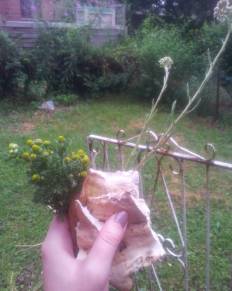
Pineappleweed, chicken-of-the-woods, yarrow – terrible phone photo, terrible phone.
Back in Reservoir Woods and almost home, I found silvery mugwort and a fine collection of pineappleweed, peppering the ground with tiny yellow suns. Mugwort is a close relative of wormwood, and has long been associated with sleep and dreaming; pineappleweed is also known as wild camomile, and its flowers are small petal-less globules which do indeed look and smell like tiny pineapples. I collected them to steep later, for tea before bed.
